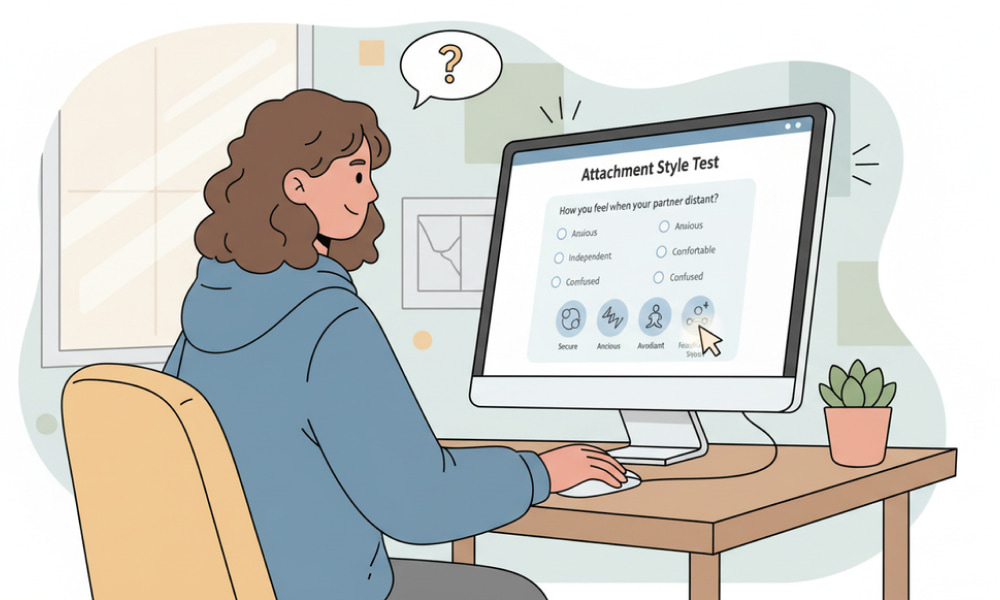Relationship Attachment Styles Test for Adults
New Updates



Take Online Attachment Styles Test
Get StartedAttachment Style Test: Discover How You Connect in Love and Life
Personal patterns in closeness, trust, and conflict management don’t come out of nowhere, and they often trace back to early relational experiences as well as later life lessons. When people grasp how they typically seek connection, they gain a clearer map for navigating intimacy, boundaries, and emotional safety. This foundation helps partners build healthier dynamics, and it also helps individuals regulate feelings, ask for what they need, and respect what others need. A grounded understanding of attachment can transform the way you communicate, soothe stress, and handle disappointment.
Most readers begin by exploring a structured self-assessment that translates abstract psychology into concrete insights they can apply right away. Many people start with an introductory attachment style test to get a snapshot before diving deeper into the science. With a few guided prompts, you can recognize patterns like protest behaviors, deactivation strategies, and key habits you may have overlooked in daily life.
Some prefer a research-informed instrument that emphasizes theory-driven dimensions and relational dynamics over simple labels. For learners who enjoy a conceptual lens, an academically oriented attachment theory test can illuminate how models of self and models of others influence behavior. Others appreciate a broad overview to spark reflection, and that is where a general-purpose attachment test can act as a gentle entry point to personal growth.

Comparing Assessments and Picking the Right Fit
Not all assessments emphasize the same factors, and your goals should shape your choice. If you want a brief pulse-check, a short inventory can deliver quick feedback. If you’re seeking a nuanced readout, choose a longer format that breaks down anxiety, avoidance, and situational triggers with more depth. By matching scope and effort to what you want to learn, you’ll get better, more actionable insights from your results.
People who want a clear reading on comfort with intimacy and autonomy may lean toward instruments designed to distinguish anxious and avoidant tendencies across common relationship scenarios. In many cases, it’s helpful to browse a few formats and then settle on an attachment styles test that reflects your priorities and time constraints.
| Assessment Type | Length | Focus | Format | Best For |
|---|---|---|---|---|
| Brief screening | 3–6 minutes | High-level pattern | Multiple choice | First-time explorers |
| Standard inventory | 8–15 minutes | Anxiety and avoidance | Scaled responses | Actionable coaching |
| In-depth profile | 15–25 minutes | Contextual nuances | Scenario-based items | Deep personal insight |
When reliability matters, look for clarity in item wording, consistent scoring, and transparent interpretation guidelines. Users aiming for fine-grained accuracy often seek an instrument marketed as an accurate attachment style test to ensure dependable feedback. Learners who are testing the waters may appreciate a no-cost option, and that’s where a trustworthy attachment styles free online test can be a practical starting point.
How to Take, Score, and Interpret Results Responsibly
Good outcomes start with thoughtful preparation and honest self-reflection. Set aside quiet time, minimize distractions, and answer according to what you typically do, not what you wish you did. Treat your results as a snapshot, remembering that context matters: different partners, life stages, and stress levels can shift how you lean in or pull back. With that mindset, your score becomes a guide rather than a verdict.
As you respond to items about closeness, reassurance, and independence, aim for consistency across similar prompts. If your purpose is focused growth, it can be helpful to pick a tool that lets you test attachment style across themes like trust, conflict, and communication. Once you receive feedback, highlight two or three takeaways and convert them into specific behaviors you can try this month.
- Turn insights into small experiments you can repeat and refine.
- Pair your results with journaling to track patterns over time.
- Share key findings with a supportive partner or friend for accountability.
- Consider therapy or coaching for personalized strategies.
When your goal is to identify barriers that keep repeating, a targeted screening can spotlight sticking points and flag areas for care, which is why some people try an attachment issues test to focus on obstacles. Couples who want a shared language for needs and boundaries sometimes prefer a tool designed for dyads, and in that case a relationship attachment style test can prompt meaningful conversation and collaborative change.
Benefits for Growth, Communication, and Wellbeing
Self-knowledge paves the way for calmer conflict, clearer requests, and more secure intimacy. By recognizing your patterns, you can replace reactive habits with deliberate responses and build trust more quickly. The payoff extends beyond romance, too: friendships and work relationships often improve when you understand how you seek safety and connection. Equipped with that clarity, you can practice new behaviors that reinforce security over time.
Some people like to benchmark their style against common categories before refining with nuance, and that’s where an attachment type test can provide an accessible framework. From there, you can personalize your plan, pairing concrete skills like self-soothing with interpersonal tools such as repair attempts and curiosity-led listening.
- Reduce miscommunication by naming needs early and plainly.
- Lower conflict intensity with timeouts and reconnection rituals.
- Build trust through consistent, bite-sized acts of reliability.
- Grow resilience with emotion regulation and compassionate self-talk.
Adults navigating dating, cohabitation, or long-term commitment often want guidance that fits their stage of life, and that’s where an attachment test for adults can offer age-relevant insights. Busy people sometimes need a streamlined option for a fast pulse-check between meetings, which is why a concise quick attachment style test can be helpful for ongoing self-monitoring.

How to Choose an Attachment Type Test
Quality matters, and so do transparency and privacy. Look for clear scoring explanations, evidence-based item design, and data policies that respect your confidentiality. Read how results are stored, whether anonymization is used, and whether your responses are shared with third parties. Equally important is the way results are framed: tools that emphasize shame-free growth usually lead to healthier change.
If budget is a factor, it’s reasonable to look for a tool that doesn’t add financial friction to your self-discovery process, and many people start with an attachment style test free to explore baseline patterns. Consider whether the site offers additional resources like worksheets, habit trackers, or communication prompts to help you apply what you learn in daily life.
Some readers want a no-cost option that offers straightforward guidance without gating essential insights, and they often appreciate a well-designed what is my attachment style free test that keeps the experience simple. Others enjoy a more playful format that still delivers meaningful takeaways, and that’s when a thoughtfully built attachment style test quiz can make the process feel engaging while remaining useful.
Take Online Attachment Styles Test
Get StartedFrequently Asked Questions
-
Can my attachment patterns change over time?
Yes, patterns can shift with new experiences, supportive relationships, and deliberate practice. Healing after stress or trauma, learning emotion regulation skills, and building trust with reliable partners can all promote greater security. Progress is rarely linear, so track trends rather than fixating on any single moment.
-
Should I take an assessment alone or with a partner?
Either approach works, depending on your goals. Taking it privately can encourage candor, while discussing results together can spark empathy and concrete agreements. If you choose to share, set a respectful tone and focus on behaviors you can each try rather than labels.
-
What if my results don’t match how I see myself?
Treat the report as a hypothesis to test in real life. Compare the feedback to recent interactions, ask trusted people for observations, and notice situations where your reactions differ. If discrepancies persist, try a different instrument or consult a professional for a more nuanced perspective.
-
How often should I retake an assessment?
Retesting every few months can be useful when you’re actively practicing new skills. Frequent check-ins are less helpful if they lead to over-analysis, so aim for intervals that let new habits stabilize. The goal is sustained change, not chasing small score fluctuations.
-
What should I do with my results after reading them?
Translate insights into small, specific actions such as one communication tweak per week. Share intentions with a supportive friend, journal your progress, and revisit strategies that worked. If you feel stuck, consider therapy or coaching to tailor practices to your context.
 Deep-Dive Guide to Modern Attachment Assessments: Methods and Meaning
Deep-Dive Guide to Modern Attachment Assessments: Methods and Meaning